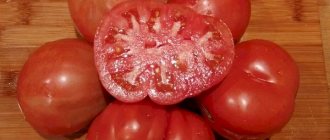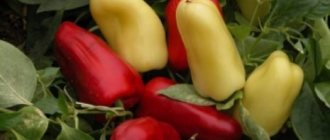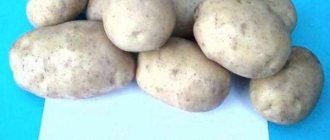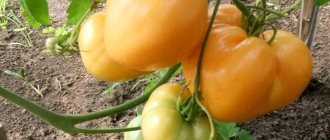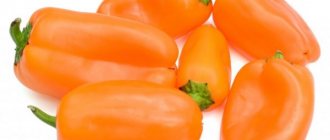Carrot Cascade f1 is part of the group of mid-late hybrids. The variety belongs to the Shantane variety. The cascade has good productivity and is resistant to fungal diseases. Root vegetables have a sweet taste and juicy pulp. A record harvest of the hybrid was recorded in the Moscow region, where 45 centners of carrots were obtained from one hectare.
Description of the carrot hybrid Cascade
Carrot Cascade is not a variety, but a hybrid belonging to the Shantanay variety. Root vegetables can be eaten fresh, used for preparing salads, making juices, baby food and dietary food.
Origin and development
Carrot Cascade F1 is a first generation hybrid bred by Dutch breeders. It was included in the State Register of Russia in 2006.
Chemical composition, trace elements and vitamins, beneficial properties
Carrot Cascade F1 contains:
- dry matter – 11.9-15.4%;
- sugar – 7.6-9.4%;
- carotene – up to 16.5 mg;
- microelements – potassium, calcium, phosphorus, chlorine, iron, magnesium;
- vitamins of group B, PP, K, C, E.
Carrots help the body resist viruses and infections, restore the intestinal microflora and normalize the gastrointestinal tract, minimize the risk of developing cancer and vascular diseases, cleanse the body of harmful waste and heavy metal salts, and have a positive effect on potency in men.
Ripening time and yield
This is a medium-late ripening hybrid: about 100-130 days pass between sowing the seeds and the onset of technical maturity of the root crops.
With proper care and compliance with the rules of agricultural technology, the marketable yield is 250-390 c/ha.
Reference. The maximum yield of this hybrid was recorded in the Moscow region - 450 c/ha.
Disease resistance
The hybrid is resistant to:
- Alternaria;
- black rot;
- cercospora.
Characteristics, description of appearance, taste
A plant with a semi-spreading rosette of leaves, the leaves are long, green, and coarsely dissected.
The root vegetables are spindle-shaped with a slightly pointed tip, they reach 18-23 cm in length, 3-4 cm in diameter, and weigh on average 130-170 g.
The surface of the vegetables is smooth, even, the bark and small core are bright orange. Carrots are juicy and have a sweet taste.
For which regions is it best suited and what are the climate requirements?
This hybrid grows well in a variety of climates.
It is included in the State Register for the Central region, but is also approved for cultivation in the North-Western, Volga-Vyatka, Central Black Earth, North Caucasus, Lower Volga, Ural, West Siberian, East Siberian and Far Eastern regions.
Description of the variety
During the growth process, carrots form a semi-spreading rosette of green, coarsely dissected leaves. The growing season lasts 120-130 days. The first root crops for food can be pulled out as early as July. The hybrid is adapted to grow in most regions of Russia.
The volume of the harvest is influenced by agricultural technology and the type of soil in which the carrots are planted. Productivity will be higher if Cascade is grown in loose and light soil. Mechanical cleaning is acceptable. The marketability of grown vegetables is 93%. The fact that the fruits look attractive can be clearly seen in the photo.
Carrots of this variety are rich in carotene. It is consumed not only fresh, but also used for preparing various dishes, baby food and dietary food. Carrots make sweet and healthy juice. From 1 kg of pulp you can get 0.5 liters of juice.
The main advantages and disadvantages of a hybrid
Pros of carrots Cascade F1:
- good taste;
- high carotene content;
- long-term storage;
- consistently high productivity;
- unpretentiousness;
- possibility of machine harvesting.
The disadvantage of the hybrid is the inability to use your own seeds.
What is the difference from others
A comparison with other carrot hybrids is presented in the table.
| Hybrid | Ripening time | Weight of root vegetables, g | Root shape | Productivity, c/ha | Carotene content, mg |
| Cascade F1 | 100-130 days | 130-170 | Fusiform with a pointed end | 250-390 | Up to 16.5 |
| Bangor F1 | 110 days | 120-200 | Cylindrical with rounded end | 196-270 | 10,1 |
| Fun F1 | 80-100 days | 47-81 | Cylindrical with blunt end | 325-474 | Up to 15.1 |
| Lagoon F1 | 80-85 days | 80-130 | Fusiform with blunt end | 186-316 | Up to 17.2 |
Features of planting and growing
You can count on a bountiful harvest only if you follow agrotechnical rules. First of all, you should correctly select and prepare the site for planting carrots and seeding material, and then provide the plants with proper care.
Preparing for landing
Preparing seeds improves their germination and helps protect plants from diseases.
There are several ways to process seed:
- soak for a day in water heated to +30°C;
- dilute 1 tbsp in warm water. l. ash, wet the seeds with the resulting solution, then rinse them, wrap them in cloth and place them on the refrigerator shelf for 48 hours;
- wrap the seeds in cotton cloth, dip them in water heated to +50°C for 2-3 minutes, and then place them in cold water to cool.
If you have a bubbler, the seed can be placed in a solution of growth stimulants (Epin, Silk) with oxygen saturation for 20 hours.
The site is prepared in the fall. The soil is dug up and fertilizers are added at the rate of 30 g of superphosphate, 15 g of potassium, 20 g of nitrogen and 2-3 kg of humus per 1 m². If these requirements are met in the spring, the ground is only trimmed with a rake.
A TINY WAY TO PLANT CARROTS WITHOUT THINING JUICY CARROTS
Soil requirements
Carrots prefer loose, fertile soil with good aeration, moisture permeability and a neutral acidity level (pH 6-7) - loam, sandstone, peat soil.
Predecessors
Compliance with the rules of crop rotation is one of the conditions for obtaining a high-quality harvest. The best predecessors of Cascade F1 are potatoes, cucumbers, zucchini, cabbage, garlic, tomatoes, onions, melons and legumes.
Dates, scheme and rules of planting
The timing of sowing seeds varies depending on climatic conditions and the purpose of using the crop. Some gardeners sow before winter in order to harvest ripe vegetables as early as possible.
Important! This method is unacceptable in regions with harsh winters and where frost returns after a thaw.
Most often, planting is carried out in the spring, when the daytime temperature is +15...+18°C, and the soil warms up to +5...+7°C.
Planting pattern:
- Form beds at a distance of at least 15 cm from each other.
- Make furrows in them for sowing seeds.
- Plant the seeds, maintaining a distance between them of 4-5 cm and deepening them by 1-2 cm.
- Sprinkle the seeds with soil.
Features of cultivation
To plant Cascade F1 carrots, choose a flat, well-lit area where water does not accumulate after rain or melting snow.
If the soil is too heavy, add sawdust soaked in a urea solution (1 bucket per 1 m²), and lime, ash and dolomite flour are used to deoxidize the soil.
Attention! Do not plant Cascade F1 after other varieties of carrots, parsley, parsnips, dill and beans.
Nuances of care
This hybrid does not require care, but, like other crops, it needs proper watering, fertilizing and loosening of the soil.
Watering mode
Cascade F1 needs regular moderate watering . Lack of moisture causes poor growth, lethargy and bitterness in the taste of root vegetables, and excessive moisture leads to cracking of vegetables and growth of tops. They focus on the condition of the soil - it should always be moistened to a depth of 30 cm.
On average, watering is carried out once a week. The water consumption is initially 3 liters per 1 m², and after the second thinning – 10 liters per 1 m². In conditions of drought or active crop growth, the volume of water per 1 m² is increased to 20 liters.
Approximately 1.5-2 months before harvesting, plants are watered once every 10-14 days (10 liters of water per 1 m²), two weeks before harvesting, watering is stopped.
Reference. After watering, the soil is loosened to improve the access of oxygen and moisture to the roots.
Thinning and weed control
It is necessary to promptly remove weeds from between rows so that they do not deplete the soil and interfere with the development of root crops.
To avoid deformation of the carrots, the seedlings are thinned out twice:
- when 3 leaves appear on the plants (about 3-4 weeks after sowing the seeds), leaving a gap of 2-2.5 cm between shoots;
- after 3 weeks - the distance between the root crops should be 4.5-5 cm.
Thinning is carried out in the evening, because during the day the smell of carrots attracts pests.
Top dressing
Cascade F1 carrots are fed twice during the growing season:
- 21-28 days after emergence;
- 2 months after the first feeding.
Fertilizer is a nutrient solution, for the preparation of which 1 tbsp is diluted in 10 liters of water. l. nitrophoska, 0.5 l of ash, 20 g of potassium nitrate, 15 g of urea and 15 g of double superphosphate.
Important! Fertilizer is applied at the root simultaneously with watering.
Disease and pest control
The hybrid is resistant to diseases and attacks by insect pests. If signs of disease development or traces of pests are found on plants, the plantings are treated with fungicides (Fundazol, HOM) or insecticides (Aktellik, Decis).
Pest, disease and weed control
Carrots can be affected by various diseases and can also be attacked by insect pests. Therefore, it is important to know what measures should be taken when a particular problem arises.
Diseases such as bacteriosis, septoria, phomosis and rot can significantly reduce yields. Infection with bacteriosis occurs through infected seeds or plant debris. Therefore, seed material should be disinfected before planting, and tops and other vegetation should be removed from the beds. The Tigama solution is well suited for disinfection.
Signs of septoria are small chlorotic spots on the leaves of the root crop, which after some time become brown. High humidity promotes the rapid spread of the disease.
To combat septoria, treatments are carried out with 1% Bordeaux mixture with an interval of 10–12 days. Severely affected specimens must be pulled out and disposed of.
Rot (gray, white, red, black) appears during storage. To eliminate the disease, soil with a high level of acidity should be limed, nitrogen-containing fertilizers should be added, and carrot plantings should be regularly cleaned of weeds.
Before storing vegetables, they should be sprinkled with chalk. It is imperative to follow the rules for storing these root vegetables. Red rot is detected in the form of brown spots on carrots, in place of which black sclerotia of the fungus appear over time.
The disease can be provoked by manure, which is used as fertilizer. Black rot can be detected by dark, rotten areas on the vegetable. Diseased specimens should be pulled out.
Carrots are also susceptible to attack by pests such as carrot flies, fall armyworms, wireworms and slugs. You can collect slugs by hand if there are only a few of them. It is also good to use traps: cans of beer are buried in the ground for this purpose.
To combat insect pests, insecticidal preparations such as Anometrine, Revikurt, and Etafos are used. To repel arthropods, you can also plant onions, garlic, marigolds or marigolds between the rows.
Harvest and storage
Carrots need to not only be grown, but also harvested correctly, providing them with suitable storage conditions.
How and when to collect
Despite the fact that carrots reach technical maturity 100-130 days after planting, individual root crops can be harvested earlier. If the seeds are sown at the end of April, the crop is ready for harvest in August.
Carrots are harvested on a dry and clear day manually (by pulling the roots out of the ground by the tops or digging them up with a shovel) or mechanically.
Storage features and shelf life of the hybrid
The collected root vegetables are carefully sorted and any damaged specimens are discarded or set aside for prompt use.
For healthy and whole root crops, the tops are cut down to the head, dried in the sun or under a canopy for several days, and then placed in wooden or plastic boxes, sprinkled with sand and taken to a cellar or basement for storage.
Important! Instead of sand, you can use onion peels - it prevents rotting, as it has bactericidal properties.
In suitable conditions, the crop is stored throughout the winter.
Some growing tricks
Despite the fact that the variety provides for obtaining a beautifully shaped and tasty vegetable, when growing it it is still worth making some efforts to achieve maximum results.
Read also: Carrot Yaroslavna Search (tape) 8 m buy at a price of 26 rubles
And so, it is best to plant carrots in loamy, fertile soil with good drainage. To do this, chernozem is mixed with peat and compost. A slight increase in soil acidity will only benefit the root crop.
In addition, it should be noted that carrots do not like fertilization with fresh manure. Nitrogen imparts bitterness to the taste and affects the appearance of the vegetable; it may become covered with cracks, the surface becomes rough, with tubercles.
Water the beds regularly, and then be sure to fluff up the soil. When active root formation occurs, fertilizer is applied in the form of a weak solution of superphosphate.
As you can see, there are no difficulties in growing vegetables. Therefore, “Cascade” carrots are an excellent variety for home gardens, which require minimal costs, but at the same time please with a rich harvest.
Reviews of the carrot hybrid Cascade
Most of the reviews from gardeners about the Cascade F1 hybrid are positive.
Lydia, Yekaterinburg: “I have been growing carrots for a long time, but in all the years I have never found a variety whose description would suit me in every way. Several years ago I tried to plant Cascade on the advice of my godfather and I won’t experiment again. I like everything – the carrots are smooth, tasty, sweet, the yield is high, and they don’t rot during storage.”
Mikhail, Yaroslavl: “Last year I sowed Cascade seeds for the first time and was completely satisfied. I’m rarely at the dacha and can’t carefully care for the plantings, but these carrots don’t require that. With little care for the beds, the harvest was excellent and was preserved in the cellar until early spring.”
